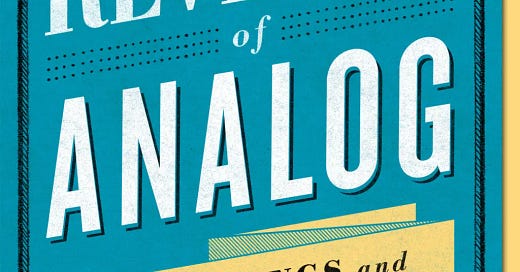The power of touch: The enduring power of analog
How books, vinyl, photography, and notebooks continue to thrive in the digital age
“The Revenge of Analog: Real Things and Why They Matter"
By David Sax
Grade: 93
I’m not sure where I learned of David Sax’s book The Revenge of Analog: Real Things and Why They Matter, but I’m glad I did. The book, written in 2016, is an easy read that’s packed to the gills with interesting anecdotes and data, all of which support his central thesis: That while digital technology continues to transform our lives in limitless ways, technology will never fully supplant the tangible, real-world benefits of analog.
He argues quite convincingly that the appeal of analog—specifically the ease with which it promotes authenticity and genuine engagement—cannot be easily replicated in the digital realm.
Why analog is more desirable now than ever
As digital interactions become more and more dominant, so does the desire for tactile, real engagement and interaction.
His claims are backed up by data
Despite the dominance of digital music formats, sales of vinyl began to soar more than a decade ago, and in 2015 sales reached 12 million units—a 30% increase—in the U.S. alone.
Sax believes the resurgence is owing to the pent up demand for a richer, more immersive listening experience. He says the tangible and tactile sensation of the covers, the artwork, and manipulating the albums on the players delivers a deeper connection to the music, one the digital cannot compete with.
Nothing replaces a book
If you know my writing at all, you know I’m a dyed-in-the-wool bibliophile, with a book collection numbering in the thousands. So, yes, I was most excited to read Sax discussing the unending appeal of print media, especially books. He writes that, even electronic books and digital readers/platforms grew in popularity in the early aughts, books remained popular. For example, in 2015 alone, print book sales returned to levels not seen since 2011, when annual book sales climbed back above 600 million.
As I well know, nothing replaces the feeling of a book in your hand as opposed to on a screen. And despite the ease of being able to carry millions of digital books with you via your phone, tablet or phablet, physical books continue to hold their own. A huge benefit—and one that I appreciate immensely—is the renewed appreciation for books has helped to stanch the tide of independent bookstore closing taking place nationwide just a few years ago.
The irreplaceable notepad
For more than a decade, I’ve carried a Moleskine notepad in my vehicle or on my person religiously. They are a mainstay, making it easy for me to jot down my thoughts or write details from an event, conversation or activity I’d like to revisit later. What I love about the Moleskine is it can be ubiquitous: I can pull it anywhere, anytime, unlike my phone, which can seem obtrusive or bring about annoyed looks if I start typing on it while talking to a friend.
“I’m writing down a few notes so I can remember the details of this conversation later” works far better with a pen and pad than it does when said while holding a phone.
Apparently I’m not alone in my love for Moleskine notebooks, as Sax writes that their sales soared in the teens, even as digital was exploding (the iPad was introduced in 2010, too), with sales reaching $100 million by 2015. Analog notebooks, which are heavily favored by students, professionals, and artists deliver an analog experience that cannot be replicated via digital technology, writes Sax. I wholeheartedly agree.
A worthy read
Sax explores these analog experiences and several others, including film, photography, education, board games, and retail shopping, and in each instance he brings to bear data highlighting how each area remains fertile ground for rich analog experiences that customers are not only craving but are willing to pay more for to enjoy.




